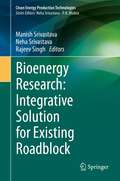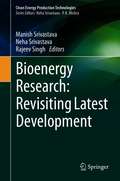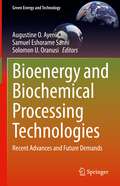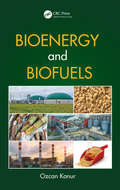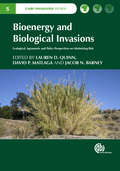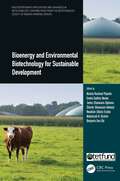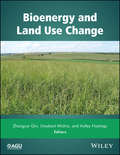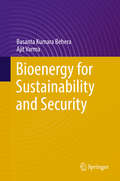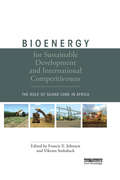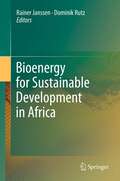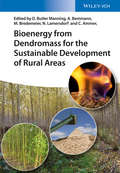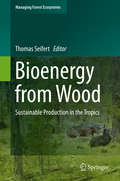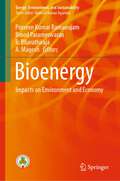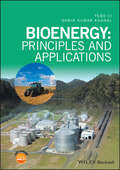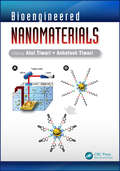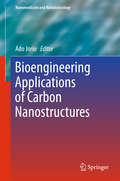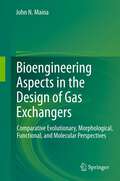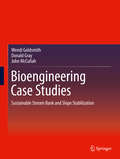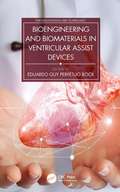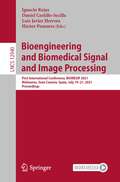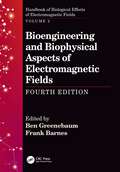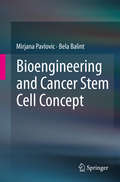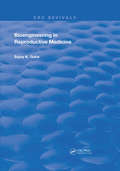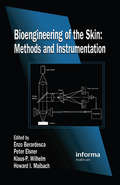- Table View
- List View
Bioenergy Research: Integrative Solution for Existing Roadblock
by Neha Srivastava Manish Srivastava Rajeev SinghThis volume is fifth part of the five-part set on bioenergy research. This edited volume provides sustainable solution for all existing roadblocks in commercial bioenergy production. The book focuses on different types of obstacles involved in various bioenergy operations with detail remedy of the issue in a sustainable way. In spite of having number of potential advantages, all available bioenergy options are still far from smooth practical applicability, due to which they are still in pipeline phase to replace the fossil fuels. This book brings together the integrative approach to the readers, to connect with more viable bioenergy type on commercial scale, the existing issues and the feasible approaches to eliminate the bottlenecks in the process. Further, the book also uncovers the untouched area of bioenergy production technology by bringing forth unconventional methods, processes and parameters, which have scope to enhance biofuel production technology by “Lab to Land” methods. The book highlights aspect which are less studied or are very new in their industrial application of bioenergy production. The book presents relevant reading material for global researchers, academic institutions, research students, teachers, scientist as well as industries. Other four volumes of this set explore basic concepts, latest progress, commercial opportunities and bio-waste to energy conversion.
Bioenergy Research: Revisiting Latest Development (Clean Energy Production Technologies)
by Neha Srivastava Manish Srivastava Rajeev SinghThis volume is second part of the five-part set on bioenergy research. This book provides new insight about the latest development in bioenergy research. It presents the various bioenergy options which are further explored for practical viability, their progress and utility in the industry. The main objective of the book is to provide insights into the opportunities and required actions for the development of an economically viable bioenergy industry for practical replacement of fossil fuels. This book is of interest to teachers, researchers, scientists, capacity builders and policymakers. Also the book serves as additional reading material for undergraduate and graduate students of environmental sciences. National and international bioenergy scientists, policy makers will also find this to be a useful read. Other four volumes of this set explore basic concepts, commercial opportunities, waste to energy and integrated solution for bioenergy concerns.
Bioenergy and Biochemical Processing Technologies: Recent Advances and Future Demands (Green Energy and Technology)
by Augustine O. Ayeni Samuel Eshorame Sanni Solomon U. OranusiThis book presents novel techniques, current trends, and cutting-edge technologies in energy and biochemical processes. The authors explore recent advances that solve challenges related to the implications and commercialization of these processes by introducing new techniques or modifying existing technologies to meet future demands for food materials, bioproducts, fossil fuels, biofuels, and bioenergy. Divided into three parts, the first section of the book addresses issues related to the utilization and management of energy towards the efficient characterization and conversion of wastes or raw-/bio- materials to useful products. The second section focuses largely on studies on molecular detection of analytes, purification, and characterization of products recovered from biochemical, enzymatic, food, and phytochemicals, as well as biostimulation and bioaugmentation processes. The final section discusses areas related to heat and mass transfer, fuel processing technologies, nanofluids, and their applications.
Bioenergy and Biofuels
by Ozcan KonurThis book aims to inform readers about the recent developments in bioenergy and biofuels covering current issues from an interdisciplinary approach. It will also feature coverage of anticipated future trends related to each particular biofuel. Chapters will consist of original research presented by world class experts in their respective fields. A number of interdisciplinary areas will be incorporated such as Energy & Fuels, Biotechology, Genomics, Economics, Optimization, Chemical Engineering, Mechanical Engineering and Algae Science. Examples will relate to a matrix of biofuel and energy types such as bioethanol, biobutanol, and biomethane.
Bioenergy and Biological Invasions
by Rachel Bethke Carol Mallory-Smith Russell Jessup Jacob N Barney Stephen F Enloe Caroline E Ridley Phang Siew Moi Larissa Smith Bryan Endres Lauren D Quinn Lloyd Nackley David MatlagaDespite major international investment in biofuels, the invasive risks associated with these crops are still unknown. A cohesive state-of-the-art review of the invasive potential of bioenergy crops, this book covers the identified risks of invasion, distributions of key crops and policy and management issues. Including a section on developing predictive models, this book also assesses the potential societal impact of bioenergy crops and how to mitigate invasive risks.
Bioenergy and Biological Invasions: Ecological, Agronomic and Policy Perspectives on Minimizing Risk (Plant Science / Horticulture Ser. #5)
by Rachel Bethke Carol Mallory-Smith Russell Jessup Stephen F Enloe Caroline E Ridley Phang Siew Moi Larissa Smith Bryan Endres Lloyd NackleyDespite major international investment in biofuels, the invasive risks associated with these crops are still unknown. A cohesive state-of-the-art review of the invasive potential of bioenergy crops, this book covers the identified risks of invasion, distributions of key crops and policy and management issues. Including a section on developing predictive models, this book also assesses the potential societal impact of bioenergy crops and how to mitigate invasive risks.
Bioenergy and Environmental Biotechnology for Sustainable Development (Multidisciplinary Applications and Advances in Biotechnology)
by Akinola Rasheed PopoolaThis book covers a range of important topics on environmental remediation, biofuels and value-added microbial products for environmental clean-up, water and wastewater recycling and sustainable wastewater treatment using microalgae. Designed to document advances in biotechnology, this book highlights bio-resource utilization in fostering low-carbon renewable energy-based economies and provides new insights into chlorine disinfectant usage in water treatment, wastewater treatment using microalgae, etc. The book will be useful reference material for scientists and researchers in the fields of microbial biotechnology and bioremediation, environmental biotechnology and sustainable development, climate change mitigation, provision of safe water and sustainable wastewater recycling. Emphasizes recent advances in bioremediation techniques towards environmental sustainability Provides detailed information on how to harness indigenous bio-resources including microorganisms as bioenhancement agents for environmental remediation Introduces new frontiers in the area of wastewater treatment using microalgae — important for sustainability and water safety Reviews biotechniques that could enhance higher levels of sustainability in heavily polluted environments and also provides an intelligent monitoring system for waste recycling and environmental remediation, and fostering a low-carbon renewable energy–based bioeconomy Discusses the need for review of existing guidelines on chlorine disinfectant usage for enhanced water quality Akinola Rasheed Popoola, Ph.D., is a Professor of Plant Pathology and the Director of the Biotechnology Centre, Federal University of Agriculture, Abeokuta, Nigeria. Emeka Godfrey Nwoba, Ph.D., is a research scholar at the Algae Research & Development Centre, Murdoch University, Western Australia. James Chukwuma Ogbonna, Ph.D., is a Professor of Microbiology and Biotechnology and Director, National Biotechnology Development Agency, South East Zonal Biotechnology Centre, University of Nigeria, Nsukka, Nigeria. Charles Oluwaseun Adetunji, Ph.D., is an Associate Professor of Microbiology and Biotechnology, and Director of Intellectual Property and Technology Transfer, Edo State University, Uzairue, Nigeria. Nwadiuto (Diuto) Esiobu, Ph.D., is a Professor of Microbiology and Biotechnology at Florida Atlantic University, Boca Raton, FL, USA, and the President and Founder of Applied Biotech Inc. and ABINL, Abuja, Nigeria. Abdulrazak B. Ibrahim, Ph.D., is a Capacity Development Expert at the Forum for Agricultural Research in Africa (FARA) and an Associate Professor of Biochemistry, Ahmadu Bello University, Zaria, Nigeria. Benjamin Ewa Ubi, Ph.D., is a Professor of Plant Breeding and Biotechnology and Director, Biotechnology Research and Development Centre, Ebonyi State University, Abakaliki, Nigeria.
Bioenergy and Land Use Change
by Zhangcai Qin Umakant Mishra Astley HastingsAlthough bioenergy is a renewable energy source, it is not without impact on the environment. Both the cultivation of crops specifically for use as biofuels and the use of agricultural byproducts to generate energy changes the landscape, affects ecosystems, and impacts the climate. Bioenergy and Land Use Change focuses on regional and global assessments of land use change related to bioenergy and the environmental impacts. This interdisciplinary volume provides both high level reviews and in-depth analyses on specific topics. Volume highlights include: Land use change concepts, economics, and modeling Relationships between bioenergy and land use change Impacts on soil carbon, soil health, water quality, and the hydrologic cycle Impacts on natural capital and ecosystem services Effects of bioenergy on direct and indirect greenhouse gas emissions Biogeochemical and biogeophysical climate regulation Uncertainties and challenges associated with land use change quantification and environmental impact assessments Bioenergy and Land Use Change is a valuable resource for professionals, researchers, and graduate students from a wide variety of fields including energy, economics, ecology, geography, agricultural science, geoscience, and environmental science.
Bioenergy for Sustainability and Security
by Ajit Varma Basanta Kumara BeheraThis book discusses the generation of green energy, providing fundamental scientific information on the availability of sustainable biological resources. It addresses inter- and multidisciplinary topics, including policies and strategies for sustainable energy; the environment and advanced renewable energy technology; electricity generation through solid waste management; and direct electricity generation using microbial fuel cells. It examines the application of the principles and quantitative relationships that define the process – as an effective technique to teach applied aspects of biomass energy technology conversion. In addition, it describes the latest commercialisation of microbial fuel cell technologies, bio-diesel production from microalgae, fermentation technology based on biobutanol from bacteria, and direct ethanol production from microalgae with attractive illustrations and models developed by corporate sectors.
Bioenergy for Sustainable Development and International Competitiveness: The Role of Sugar Cane in Africa
by Francis X. JohnsonGrowing concerns about the impacts of climate change and dependence on fossil fuels have intensified interest in bioenergy from sugar cane and other crops, highlighting important links between energy, environment and development goals. Sub-Saharan Africa is characterized by severe poverty; the possibility to exploit a renewable energy resource offers valuable avenues for sustainable development and could support a more dynamic and competitive economy. This book describes how the bioenergy expansion will improve rural livelihoods, reduce costly energy imports, reduce GHG emissions, and offer new development paths. Drawing on international experience, it is shown that harnessing this potential will require significant increases in investment, technology transfer, and international cooperation. Because of its high efficiency, the authors argue that sugar cane should be viewed as a global resource for sustainable development and should command much greater focus and concerted policy action. Through an analysis of the agronomy, land suitability and industrial processing of sugar cane and its co-products, along with an assessment of the energy, economic and environmental implications, this volume demonstrates that sugar cane offers a competitive and environmentally beneficial resource for Africa's economic development and energy security. With forty-four authors representing thirty organisations in sixteen countries, the book offers a truly international and interdisciplinary perspective by combining technical and economic principles with social, political and environmental assessment and policy analysis.
Bioenergy for Sustainable Development in Africa
by Dominik Rutz Rainer JanssenThe work builds on the results of the COMPETE Bioenergy Competence Platform for Africa, which was supported by the European Commission and coordinated by WIP Renewable Energies, Germany. The five sections cover biomass production and use, biomass technologies and markets in Africa, biomass policies, sustainability, and financial and socio-economic issues. This valuable work is, in effect, a single-source treatment of a key energy sector in a part of the world which still has a lot of unrealised potential for development.
Bioenergy from Dendromass for the Sustainable Development of Rural Areas
by Albrecht Bemmann Michael Bredemeier Christian Ammer Norbert Lamersdorf David Butler ManningBased on the results of two bioenergy research initiatives in Germany, this reference examines the sustainable management of wood biomass in rural areas. The large number of participating organizations and research institutes ensures a balanced and unbiased view on the potentials and risks is presented, taking into account economic, ecological, and social aspects. Most of the results reported are available here for the first time in English and have been collated in central Europe, but are equally applicable to other temperate regions. They highlight best practices for enhancing dendromass potential and productivity, while discussing the implications on rural economies and ecosystems.
Bioenergy from Wood: Sustainable Production in the Tropics (Managing Forest Ecosystems #26)
by Thomas SeifertThis book is written for scientists and practitioners interested in deepening their knowledge of the sustainable production of bioenergy from wood in tropical and sub-tropical countries. Utilising the value chain concept, this book outlines the necessary aspects for managing sustainable bioenergy production. A wide range of topics is covered including biomass localization, modelling and upscaling, production management in woodlands and plantations, and transport and logistics. Biomass quality and conversion pathways are examined in order to match the conversion technology with the available biomass. A section is dedicated to issues surrounding sustainability. The issues, covered in a life-cycle assessment of the bioenergy system, include socio-economic challenges, local effects on water, biodiversity, nutrient-sustainability and global impacts. Through this holistic approach and supporting examples from tropical and sub-tropical countries, the reader is guided in designing and implementing a value chain as the main management instrument for sustainable wood.
Bioenergy: Impacts on Environment and Economy (Energy, Environment, and Sustainability)
by Binod Parameswaran B. Bharathiraja Praveen Kumar Ramanujam A. MageshThis contributed volume discusses the impact of bioenergy on the environment and economy. The book contents include contributions on themes, such as the impact of emulsified biofuels on the environment, environmental impacts of the current uses of biomass energy, sustainable development in ecosystem, trends in microbial fuel cells and the ecological and economic impacts on biofuel production, among others. The book also uses visual elements to aid learning. This book is a valuable, hands-on resource for researchers, academics and industry professionals, who are interested in alternative fuels, sustainability, clean energy, biofuel production, waste management, environmental pollution, renewable energy and allied fields.
Bioenergy: Principles and Applications
by Yebo Li Samir Kumar KhanalThe search for altenative, renewable sources of fuel and energy from plants, algae, and waste materials has catalyzed in recent years. With the growing interest in bioenergy development and production there has been increasing demand for a broad ranging introductory text in the field. Bioenergy: Principles and Practices provides an invaluable introduction to the fundamentals of bioenergy feedstocks, processing, and industry. Bioenergy provides readers with an understanding of foundational information on 1st, 2nd, and 3rd generation biofuels. Coverage spans from feedstock production of key energy sources such as grasses, canes, and woody plants through chemical conversion processes and industrial application. Each chapter provides a thorough description of fundamental concepts, definitions of key terms, case studies and practical examples and exercises. Bioenergy: Principles and Practices will be an essential resource for students, bioengineers, chemists, and industry personnell tying key concepts of bioenergy science to valuable real world application.
Bioengineered Nanomaterials
by Atul Tlwarl Ashutosh TlwarlMany varieties of new, complex diseases are constantly being discovered, which leaves scientists with little choice but to embrace innovative methods for controlling the invasion of life-threatening problems. The use of nanotechnology has given scientists an opportunity to create nanomaterials that could help medical professionals in diagnosing and
Bioengineering Applications of Carbon Nanostructures (Nanomedicine and Nanotoxicology)
by Ado JorioThis book covers the development of biotechnology based on carbon nanostructures, with a focus on nanotubes, addressing also fullerenes and amorphous carbons. The book is divided into 7 chapters, addressing tissue engineering, genetic engineering and therapy, as well as the environmental and health impacts of carbon nanostructures.
Bioengineering Aspects in the Design of Gas Exchangers: Comparative Evolutionary, Morphological, Functional, and Molecular Perspectives
by John N. MainaThis book encapsulates over three decades of the author's work on comparative functional respiratory morphology. It provides insights into the mechanism(s) by which respiratory means and processes originated and advanced to their modern states. Pertinent cross-disciplinary details and facts have been integrated and reexamined in order to arrive at more robust answers to questions regarding the basis of the functional designs of gas exchangers. The utilization of oxygen for energy production is an ancient process, the development and progression of which were underpinned by dynamic events in the biological, physical, and chemical worlds. Many books that have broached the subject of comparative functional respiratory biology have only described the form and function of the 'end-product,' the gas exchanger; they have scarcely delved into the factors and the conditions that motivated and steered the development from primeval to modern respiratory means and processes. This book addresses and answers broad questions concerning the critical synthesis of multidisciplinary data, and clarifies previously cryptic aspects of comparative respiratory biology.
Bioengineering Case Studies: Sustainable Stream Bank and Slope Stabilization
by Wendi Goldsmith Donald Gray John Mccullah"Bio-Stabilization Case Studies: Treatment and Performance Evaluation" describes and evaluates 30 projects from across the United States where bio-stabilization was employed to address a detrimental naturally occurring process or byproduct of the built environment. Bio-stabilization (or soil bioengineering) refers to the use of plant materials, primarily live cuttings, arranged in the ground in different arrays to reinforce soils and protect upland slopes and/or stream banks against surficial erosion and shallow slope failures. Examples included in the collection represent different regions of the country and their specific conditions and challenges. Each project is illustrated with a number of distinctive photographs to support the reader's understanding and showcase the wide scope of projects and techniques presented. The volume is ideal for civil and environmental engineers and environmental scientists working on watershed, infrastructure projects, and municipal scale installations.
Bioengineering and Biomaterials in Ventricular Assist Devices (Emerging Materials and Technologies)
by Eduardo Guy Perpétuo BockOften associated with artificial hearts, ventricular assist devices (VADs) are blood pumps that can provide circulatory assistance to the left ventricle, the right ventricle, or both. Bioengineering and Biomaterials in Ventricular Assist Devices reviews constructive details of VADs and the biomaterials used in their development and support. FEATURES Establishes an area of intersection between engineering and medicine Shows process development from mechanical design to automation and control Discusses biofunctional materials, tribology in ceramic biomaterials, biosensors, and surface engineering and blood This text is aimed at advanced students, researchers, and practicing engineers conducting work on VADs and will be of interest to a broad interdisciplinary group, including bioengineers, materials engineers, chemical engineers, mechanical engineers, and electrical engineers.
Bioengineering and Biomedical Signal and Image Processing: First International Conference, BIOMESIP 2021, Meloneras, Gran Canaria, Spain, July 19-21, 2021, Proceedings (Lecture Notes in Computer Science #12940)
by Ignacio Rojas Héctor Pomares Luis Javier Herrera Daniel Castillo-SecillaThis book constitutes the refereed proceedings of the First International Conference on Bioengineering and Biomedical Signal and Image Processing, BIOMESIP 2021, held in Meloneras, Gran Canaria, Spain, in July 2021. The 41 full and 5 short papers were carefully reviewed and selected from 121 submissions. The papers are grouped in topical issues on biomedical applications in molecular, structural, and functional imaging; biomedical computing; biomedical signal measurement, acquisition and processing; computerized medical imaging and graphics; disease control and diagnosis; neuroimaging; pattern recognition and machine learning for biosignal data; personalized medicine; and COVID-19.
Bioengineering and Biophysical Aspects of Electromagnetic Fields, Fourth Edition (Handbook of Biological Effects of Electromagnetic Fields)
by Frank Barnes Ben GreenebaumThe two volumes of this new edition of the Handbook cover the basic biological, medical, physical, and electrical engineering principles. They also include experimental results concerning how electric and magnetic fields affect biological systems—both as potential hazards to health and potential tools for medical treatment and scientific research. They also include material on the relationship between the science and the regulatory processes concerning human exposure to the fields. Like its predecessors, this edition is intended to be useful as a reference book but also for introducing the reader to bioelectromagnetics or some of its aspects. FEATURES • New topics include coverage of electromagnetic effects in the terahertz region, effects on plants, and explicitly applying feedback concepts to the analysis of biological electromagnetic effects • Expanded coverage of electromagnetic brain stimulation, characterization and modeling of epithelial wounds, and recent lab experiments on at all frequencies • Section on background for setting standards and precautionary principle • Discussion of recent epidemiological, laboratory, and theoretical results; including: WHO IARC syntheses of epidemiological results on both high and low frequency fields, IITRI lab study of cancer in mice exposed to cell phone-like radiation, and other RF studies • All chapters updated by internationally acknowledged experts in the field
Bioengineering and Cancer Stem Cell Concept (SpringerBriefs in Computer Science #0)
by Bela Balint Mirjana PavlovicThis book explores the role of cancer stem cells in the diagnosis, treatment, and cure of cancers. This book also tackles novel methodology for cancer stem cell marker identification, cancer stem cell respiration and metabolism, genetic and epigenetic mechanisms including DNA methylation, and mi-RNA assemble. It also emphasizes the role of Bioinformatics techniques, which provide a novel methodology for modeling cancer outcomes. The authors investigate the difference between cancer stem cells and normal stem cells, along with the concept of targeted cancer stem cell therapy. Although the theoretical explanations of cancer stem cell involvement in leukemia and solid cancers are controversial, there is now little doubt that cancer stem cells exist within otherwise heterogeneous cancer cell population. The brief examines the two leading theories, hierarchical and the stochastic/cancer stem cell model. Researchers, professors and advanced-level students focused on bioengineering and computer science will find this book to be a valuable resource. It is a very good source of critical references for understanding of this problem, and a useful tool for professionals in related fields.
Bioengineering in Reproductive Medicine (Routledge Revivals)
by Sujoy K. GuhaFirst published in 1990: The book discusse the use of Biomedical engineering in Reproductive Medicine.
Bioengineering of the Skin: Methods and Instrumentation, Volume III (Dermatology: Clinical And Basic Science Ser. #9)
by Howard I. Maibach Peter Elsner Enzo Berardesca Klaus-P. WilhelmSkin bioengineering is an expanding field of investigative and clinical dermatology. This guide describes all commercially available techniques and instruments. It provides a thorough overview of methods for noninvasive investigation of skin function. Commercially available instruments are reviewed and compared, with updated references given for each instrument. This book offers a technical analysis of each instrument, allowing investigators to understand its biophysical principles and to make better purchases of lab instruments. Addresses of manufacturers and worldwide distributors are included, making this an essential reference source.Chapters are written by international experts. Topics include transepidermal water loss, hydration, the measurement of skin blood flow in Laser-Doppler flowetry, sebum, pH and ions, and transcutaneous pO2 and pO2 measurements. Skin color, roughness, and elasticity are examined in detail. Skin imaging techniques, capillaroscopy, and fluorescence videomicroscopy are described. Instruments for surface microscopy of the skin are also discussed.Bioengineering of the Skin explains state-of-the-art techniques and is valuable reading for anyone who needs to stay abreast of the latest activities in this ever-changing field.
